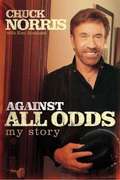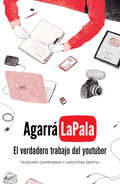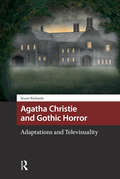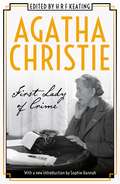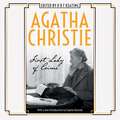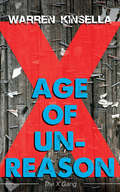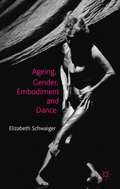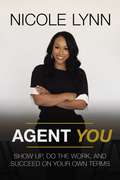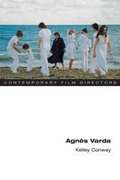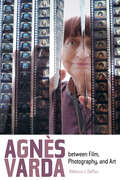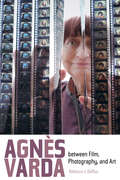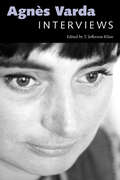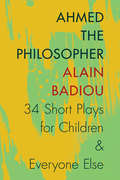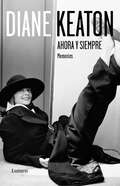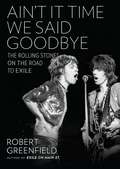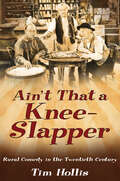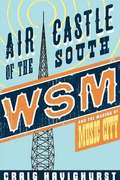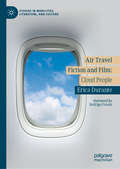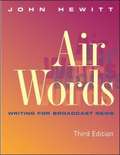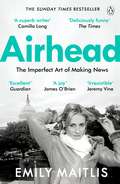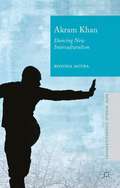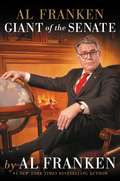- Table View
- List View
Against All Odds
by Ken Abraham Chuck NorrisNorris describes himself as a shy youth who finally blossomed while studying martial arts as a soldier in South Korea. His self-deprecating humor shows through anecdotes about karate defeats, white-knuckled speaking engagements, and his failure to become a Los Angeles policeman, which led to his fame as a karate champion.
Agarrá la pala: El verdadero trabajo del youtuber
by Teodoro Ciampagna Alejandro Bacile¿Cuál es el verdadero trabajo del youtuber? Ellos mismos te lo cuentan. Mucho se habla de que los youtubers son un montón de vagos que hace pavadas frentes a una camarita. Lo cierto es que cambiaron el paradigma de la comunicación y son los dueños de la audiencia de todas las edades; cada uno con su talento particular. ¿Cuál es su verdadero trabajo? ¿Cuánto tiempo les lleva? ¿Por qué lo hacen? ¿Son todos amigos o hay rivalidades? Esas y muchas otras preguntas más son respondidas en este libro por los youtubers más importantes de la Argentina.
Agatha Christie and Gothic Horror: Adaptations and Televisuality (Horror and Gothic Media Cultures)
by Stuart RichardsAgatha Christie’s work has been adapted extensively resulting in transformations that are both textual and cultural. While many adaptations are best known for being quaint murder mysteries, there are many adaptations of her work that draw on horror aesthetics. This book will look at how the growth of Agatha Christie adaptations have grown increasingly darker. Of key relevance to this study is the work of Sarah Phelps, whose Witness for the Prosecution, And Then There Were None, Ordeal by Innocence, The ABC Murders and The Pale Horse all are darker than their precedents. Born out of their contemporary screen contexts, they use entrenched literary and filmic codes of Gothic horror as central reference points for audiences. Drawing on adaptation scholarship, where adapters are interpreters as well as creators, this study will look at how Agatha Christie is closer to Gothic horror than what we realise. • Analysis of Agatha Christie adaptations and the horror genre. • First major monograph to explore Sarah Phelps work on Agatha Christie. • Explores the transcultural adaptations of Agatha Christie.
Agatha Christie: First Lady of Crime
by Agatha ChristieIncludes a new introduction from Sophie Hannah, bestselling author of THE MONOGRAM MURDERS and HAVEN'T THEY GROWNAgatha Christie was not only the biggest selling writer of detective stories the world has ever known, she was also a mystery in herself, giving only the rarest interviews, declining absolutely to become any sort of public figure, and a mystery too in the manner in which she achieved her astonishing success.H R F Keating, a crime novelist and respected reviewer of crime fiction, brought together a dozen distinguished writers from both sides of the Atlantic to throw light on this double mystery. Some analyse the art itself; some explain the reasons for her success, not just the books, but also in film and theatre.The approaches are penetrating, affectionate, enthusiastic, analytical, funny - even critical. Together, they give an almost unique insight into the life and work of the First Lady of Crime.
Agatha Christie: First Lady of Crime
by Agatha ChristieIncludes a new introduction from Sophie Hannah, bestselling author of THE MONOGRAM MURDERS and HAVEN'T THEY GROWNAgatha Christie was not only the biggest selling writer of detective stories the world has ever known, she was also a mystery in herself, giving only the rarest interviews, declining absolutely to become any sort of public figure, and a mystery too in the manner in which she achieved her astonishing success.H R F Keating, a crime novelist and respected reviewer of crime fiction, brought together a dozen distinguished writers from both sides of the Atlantic to throw light on this double mystery. Some analyse the art itself; some explain the reasons for her success, not just the books, but also in film and theatre.The approaches are penetrating, affectionate, enthusiastic, analytical, funny - even critical. Together, they give an almost unique insight into the life and work of the First Lady of Crime.
Age of Cage: Four Decades of Hollywood Through One Singular Career
by Keith Phipps“Age of Cage might be the closest we will get to understanding the singular beauty of each of Nic Cage’s always electric performances. You are holding the Rosetta Stone for Cage. Enjoy it.”—Paul Scheer, actor, writer and host of the How Did This Get Made? and Unspooled podcastsIcon. Celebrity. Artist. Madman. Genius. Nicolas Cage is many things, but love him, or laugh at him, there's no denying two things: you’ve seen one of his many films, and you certainly know his name. But who is he, really, and why has his career endured for over forty years, with more than a hundred films, and birthed a million memes?Age of Cage is a smart, beguiling book about the films of Nicolas Cage and the actor himself, as well as a sharp-eyed examination of the changes that have taken place in Hollywood over the course of his career. Critic and journalist Keith Phipps draws a portrait of the enigmatic icon by looking at—what else?—Cage’s expansive filmography.As Phipps delights in charting Cage’s films, Age of Cage also chronicles the transformation of film, as Cage’s journey takes him through the world of 1980s comedies (Valley Girl, Peggy Sue Got Married, Moonstruck), to the indie films and blockbuster juggernauts of the 1990s (Wild at Heart, Leaving Las Vegas, Face/Off, Con Air), through the wild and unpredictable video-on-demand world of today. Sweeping in scope and intimate in its profile of a fiercely passionate artist, Age of Cage is, like the man himself, surprising, insightful, funny, and one of a kind. So, snap out of it, and enjoy this appreciation of Nicolas Cage, national treasure.
Age of Minority: Three Plays by Jordan Tannahill
by Jordan TannahillBased on a true story, Get Yourself Home Skyler James follows the harrowing journey of a young lesbian who defects from the army when she is outed by fellow soldiers. Peter Fechter: 52 Minutes chronicles the last hour of Peter Fechter's life, a teenager in East Berlin shot while attempting to cross the Berlin Wall in 1962 with his companion. Finally, rihannaboi95 centres around a Toronto teen whose world comes crashing in when YouTube videos of him dancing to songs by his favourite pop heroine go viral. Together these solo plays explore the lives of three queer youth and their resilience in the face of violence and intolerance.
Age of Unreason: The X Gang (The X Gang #3)
by Warren KinsellaThe X Gang must stand up for their beliefs in a changing world. A new face of violence and hate has come to Portland, Maine, and the punks in the X Gang find themselves targeted once again. It is the early eighties, and the youth subculture they have grown up in is changing. Kurt, X, and the others have reluctantly concluded that they are unlikely to ever change the world with their punk anthems, but that injustice is still worth fighting against. The friends lean on each other for the strength to deal with death, addiction, sexism, and racism they see all around them. Meanwhile, the police and the FBI are on the trail of a killer, and a member of the X Gang holds the secret to the fugitive’s sinister motivations. Age of Unreason tells the shocking story of how hatred can become a cause, and how we must stand together against it no matter the cost.
Ageing Masculinities in Contemporary European and Anglophone Cinema (Routledge Advances in Film Studies)
by Tony Tracy Michaela Schrage-FrühThis volume offers a unique exploration of how ageing masculinities are constructed and represented in contemporary international cinema. With chapters spanning a range of national cinemas, the primarily European focus of the book is juxtaposed with analysis of the social and cultural constructions of manhood and the "anti-ageing" impulses of male stardom in contemporary Hollywood. These themes are inflected in different ways throughout the volume, from considering how old age is not the monolithic and unified life stage with which it is often framed, to exploring issues of queerness, sexuality, and asexuality, as well as themes such as national cinema and dementia. Offering a diverse and multifaceted portrait of ageing and masculinity in contemporary cinema, this book will be of interest to scholars and students of film and screen studies, gender and masculinity studies, and cultural gerontology.
Ageing, Gender, Embodiment and Dance
by Elisabeth SchwaigerThis book explores the nexus between gender, ageing and culture in dancers practicing a variety of genres. It challenges existing cultural norms which equate ageing with bodily decline and draws on an interdisciplinary theoretical framework to explore alternatives for developing a culturally valued mature subjectivity through the practice of dance.
Agent You: Show Up, Do the Work, and Succeed on Your Own Terms
by Nicole LynnWhat does it take to achieve your personal and professional goals? When is the right time to take calculated risks, and how do you prepare for the moment when opportunity presents itself?If anyone can show you how to do this, it&’s Nicole Lynn. As the first Black female agent to represent a top three NFL draft pick, Nicole worked her way from childhood poverty to become a Wall Street financial analyst, then attorney, and now top agent to elite athletes and entertainers.In a male-dominated profession, her extraordinary success was earned through a combination of hard work, preparation, self-advocacy, tenacity, and faith."In this book, Nicole reveals her incredible journey and how she got where she is today." -Gabrielle Union (from the foreword)Agent You shares Nicole&’s key strategies for creating a plan and executing it, even in the face of self-doubt and external obstacles. Each chapter includes exercises to help you implement the strategies presented, so you can start working toward your goals today. After reading Agent You, you&’ll learn how to:Discover and stay focused on your purpose.Develop your personal brand and advocate for yourself.Prepare for big opportunities.Land your dream job.Manage your workload and still prioritize self-care. You define what success looks like, unlock a plan to succeed on your own terms.What will your legacy be? Regardless of what life&’s challenges you face, everyone can own their success story -- and Nicole believes you are your best agent.Now is your time. Time for you to walk in your purpose. Time for you to claim your peace. Time for you to own your success story. Are you ready?
Agnes Varda (Contemporary Film Directors)
by Kelley ConwayBoth a precursor to and a critical member of the French New Wave, Agnès Varda weaves documentary and fiction into tapestries that portray distinctive places and complex human beings. Critics and aficionados have celebrated Varda's independence and originality since the New Wave touchstone Cleo from 5 to 7 (1962) brought her a level of international acclaim she has yet to relinquish. Film historian Kelley Conway traces Varda's works from her 1954 debut La Pointe Courte through a varied career that includes nonfiction and fiction shorts and features, installation art, and the triumphant 2008 documentary The Beaches of Agnès . Drawing on Varda's archives and conversations with the filmmaker, Conway focuses on the concrete details of how Varda makes films: a project's emergence, its development and the shifting forms of its screenplay, the search for financing, and the execution from casting through editing and exhibition. In the process, she departs from film history's traditional view of the French New Wave and reveals one artist's nontraditional trajectory through independent filmmaking. The result is an intimate consideration that reveals the artistic consistencies and bold changes in the career of one of the world's most exuberant and intriguing directors.
Agnes Varda between Film, Photography, and Art
by Rebecca J. DeRooAgnès Varda is a prolific film director, photographer, and artist whose cinematic career spans more than six decades. Today she is best known as the innovative "mother" of the French New Wave film movement of the 1950s and '60s and for her multimedia art exhibitions. Varying her use of different media, she is a figure who defies easy categorization. In this extensively researched book, Rebecca J. DeRoo demonstrates how Varda draws upon the histories of art, photography, and film to complicate the overt narratives in her works and to advance contemporary cultural politics. Based on interviews with Varda and unparalleled access to Varda's archives, this interdisciplinary study constructs new frameworks for understanding one of the most versatile talents in twentieth and twenty-first century culture.
Agnes Varda between Film, Photography, and Art
by Rebecca J. DerooAgnès Varda is a prolific film director, photographer, and artist whose cinematic career spans more than six decades. Today she is best known as the innovative “mother” of the French New Wave film movement of the 1950s and '60s and for her multimedia art exhibitions. Varying her use of different media, she is a figure who defies easy categorization. In this extensively researched book, Rebecca J. DeRoo demonstrates how Varda draws upon the histories of art, photography, and film to complicate the overt narratives in her works and to advance contemporary cultural politics. Based on interviews with Varda and unparalleled access to Varda's archives, this interdisciplinary study constructs new frameworks for understanding one of the most versatile talents in twentieth and twenty-first century culture.
Agnes Varda: Interviews (Conversations with Filmmakers Series)
by T. Jefferson KlineOver nearly sixty years, Agnès Varda (b. 1928) has given interviews that are revealing not only of her work, but of her remarkably ambiguous status. She has been called the “Mother of the New Wave” but suffered for many years for never having been completely accepted by the cinematic establishment in France. Varda's first film, La Pointe Courte (1954), displayed many of the characteristics of the two later films that launched the New Wave, Truffaut's 400 Blows and Godard's Breathless. In a low-budget film, using (as yet) unknown actors and working entirely outside the prevailing studio system, Varda completely abandoned the “tradition of quality” that Truffaut was at that very time condemning in the pages of Cahiers du cinema. Her work, however, was not “discovered” until after Truffaut and Godard had broken onto the scene in 1959. Varda's next film, Cleo from 5 to 7, attracted considerably more attention and was selected as France's official entry for the Festival in Cannes. Ultimately, however, this film and her work for the next fifty years continued to be overshadowed by her more famous male friends, many of whom she mentored and advised. Her films have finally earned recognition as deeply probing and fundamental to the growing awareness in France of women's issues and the role of women in the cinema. “I'm not philosophical,” she says, “not metaphysical. Feelings are the ground on which people can be led to think about things. I try to show everything that happens in such a way and ask questions so as to leave the viewers free to make their own judgments.” The panoply of interviews here emphasizes her core belief that “we never stop learning” and reveal the wealth of ways to answer her questions.
Ahmed the Philosopher: Thirty-Four Short Plays for Children and Everyone Else
by Alain BadiouEnglish-speaking readers might be surprised to learn that Alain Badiou writes fiction and plays along with his philosophical works and that they are just as important to understanding his larger intellectual project. In Ahmed the Philosopher, Badiou's most entertaining and accessible play, translated into English here for the first time, readers are introduced to Badiou's philosophy through a theatrical tour de force that has met with much success in France. <P><P> Ahmed the Philosopher presents its comic hero, the "treacherous servant" Ahmed, as a seductively trenchant philosopher even as it casts philosophy itself as a comic performance. The comedy unfolds as a series of lessons, with each "short play" or sketch illuminating a different Badiousian concept. Yet Ahmed does more than illustrate philosophical abstractions; he embodies and vivifies the theatrical and performative aspects of philosophy, mobilizing a comic energy that exposes the emptiness and pomp of the world. Through his example, the audience is moved to a living engagement with philosophy, discovering in it the power to break through the limits of everyday life.
Ahora y siempre: Memorias
by Diane KeatonLas memorias íntimas de Diane Keaton «¿Casarme? Yo no quería ser la mujer de nadie. Lo que me apetecía era ser una chica sexi, alguien con quien darse el lote.»Diane Keaton Ahora y siempre es un libro emocionante y divertido como la propia Diane Keaton. Cuenta la historia de una chica corriente que se convirtió en una mujer extraordinaria y el papel fundamental que su madre jugó en todo ello. Esta es la autobiografía de una de las actrices más aclamada de todos los tiempos pero también el relato vital de una madre y una hija, de sus sueños individuales y compartidos.
Ain't It Time We Said Goodbye: The Rolling Stones on the Road to Exile
by Robert GreenfieldFor ten days in March 1971, the Rolling Stones traveled by train and bus to play two shows a night in many of the small theaters and town halls where their careers began. No backstage passes. No security. No sound checks or rehearsals. And only one journalist allowed. That journalist now delivers a full-length account of this landmark event, which marked the end of the first chapter of the Stones’ extraordinary career. Ain’t It Time We Said Goodbye is also the story of two artists on the precipice of mega stardom, power, and destruction. For Mick and Keith, and all those who traveled with them, the farewell tour of England was the end of the innocence. Based on Robert Greenfield’s first-hand account and new interviews with many of the key players, this is a vibrant, thrilling look at the way it once was for the Rolling Stones and their fans#151;and the way it would never be again.
Ain't That a Knee-Slapper: Rural Comedy in the Twentieth Century
by Tim HollisThere was a time when rural comedians drew most of their humor from tales of farmers' daughters, hogs, hens, and hill country high jinks. Lum and Abner and Ma and Pa Kettle might not have toured happily under the "Redneck" marquee, but they were its precursors.In Ain't That a Knee-Slapper: Rural Comedy in the Twentieth Century, author Tim Hollis traces the evolution of this classic American form of humor in the mass media, beginning with the golden age of radio, when such comedians as Bob Burns, Judy Canova, and Lum and Abner kept listeners laughing. The book then moves into the motion pictures of the 1930s, 1940s, and 1950s, when the established radio stars enjoyed second careers on the silver screen and were joined by live-action renditions of the comic strip characters Li'l Abner and Snuffy Smith, along with the much-loved Ma and Pa Kettle series of films. Hollis explores such rural sitcoms as The Real McCoys in the late 1950s and from the 1960s, The Andy Griffith Show, The Beverly Hillbillies, Green Acres, Hee Haw, and many others. Along the way, readers are taken on side trips into the world of animated cartoons and television commercials that succeeded through a distinctly rural sense of fun.While rural comedy fell out of vogue and networks sacked shows in the early 1970s, the emergence of such hits as The Dukes of Hazzard brought the genre whooping back to the mainstream. Hollis concludes with a brief look at the current state of rural humor, which manifests itself in a more suburban, redneck brand of standup comedy.
Air Castle of the South: WSM and the Making of Music City
by Craig HavighurstStarted by the National Life and Accident Insurance Company in 1925, WSM became one of the most influential and exceptional radio stations in the history of broadcasting and country music. WSM gave Nashville the moniker "Music City USA" as well as a rich tradition of music, news, and broad-based entertainment. With the rise of country music broadcasting and recording between the 1920s and '50s, WSM, Nashville, and country music became inseparable, stemming from WSM's launch of the Grand Ole Opry, popular daily shows like Noontime Neighbors, and early morning artist-driven shows such as Hank Williams on Mother's Best Flour. Sparked by public outcry following a proposal to pull country music and the Opry from WSM-AM in 2002, Craig Havighurst scoured new and existing sources to document the station's profound effect on the character and self-image of Nashville. Introducing the reader to colorful artists and businessmen from the station's history, including Owen Bradley, Minnie Pearl, Jim Denny, Edwin Craig, and Dinah Shore, the volume invites the reader to reflect on the status of Nashville, radio, and country music in American culture.
Air Travel Fiction and Film: Cloud People (Studies in Mobilities, Literature, and Culture)
by Erica DuranteAir Travel Fiction and Film: Cloud People explores how, over the past four decades, fiction and film have transformed our perceptions and representations of contemporary air travel. Adopting an interdisciplinary approach, the book provides a comprehensive analysis of a wide range of international cultural productions, and elucidates the paradigms and narratives that constitute our current imaginary of air mobility. Erica Durante advances the hypothesis that fiction and film have converted the Airworld—the world of airplanes and airport infrastructures—into a pivotal anthropological place that is endowed with social significance and identity, suggesting that the assimilation of the sky into our cultural imaginary and lifestyle has metamorphosed human society into “Cloud People.” In its examination of the representations of air travel as an epicenter of today’s world, the book not only illustrates a novel perspective on contemporary fiction, but fills an important gap in the study of globalization within literary and film studies.
Air Words: Writing for Broadcast News
by John HewittAn introductory text for broadcast newswriting, with numerous exercises and examples illustrating broadcast news style. Defines and explains standard industry formats, rules, and procedures, and covers fact checking, ethics, script formats, shifting from print to broadcast, writing leads, interviews, aspects of TV writing, and copyediting and producing. Includes chapter glossaries. This second edition discusses technology advances such as wire capture and producing from CRTs. Lacks a bibliography. Annotation c. by Book News, Inc., Portland, Or.
Airhead: The Imperfect Art of Making News
by Emily MaitlisFEATURING EMILY MAITLIS' GROUNDBREAKING INTERVIEW WITH PRINCE ANDREWThe news has never been more prominent - but are we getting the full story? Newsnight presenter Emily Maitlis gives us a behind-the-scenes look at some of the biggest news stories and interviews of recent years 'Smart, funny and brilliantly told' Elizabeth Day 'Revelatory, riveting and frequently hilarious' James O'Brien 'Absolutely irresistible' Jeremy Vine ________ In this no holds barred account of life in the seconds before, during and after going on air, Newsnight presenter, leading journalist, and queen of the side eye Emily Maitlis gives us the insider info on what we don't get to see on-screen. Giving us the inside scoop on her interviews with everyone from Emma Thompson to Russell Brand, and Donald Trump to Tony Blair, as well as covering news stories such as President Clinton's affairs, Boris Johnson's race to PM, Grenfell, #MeToo, and that interview with Prince Andrew. Airhead is a brilliant exposé of the moments that never make the news. From News Presenter of the Year and 2020 BAFTA nominee ________ 'Funny and subtly smart' GUARDIAN, BOOKS OF THE YEAR DAILY MAIL BOOKS OF THE YEAR 'Deliciously funny . . . Irresistible' The Times '[Emily] is so absolutely of the moment' Evening Standard
Akram Khan
by Royona MitraAkram Khan: Dancing New Interculturalism analyses the relationship between this seminal British-Asian choreographer's complex identity-positions and his art through the lens of 'new interculturalism'. Through seven key case studies from Khan's oeuvre, this book demonstrates how Khan's philosophy and aesthetic of 'new interculturalism' is a challenge to the 1980s predominantly western 'intercultural theatre' project, as a more nuanced and embodied approach to representing Othernesses, from his own position of the Other. Additionally, the book challenges popular perception of Khan's art as contemporary South Asian dance by suggesting that, instead, Khan uses South Asian dramaturgical principles to transform the western contemporary dance landscape in intercultural ways. Offering the first full-length investigation of Akram Khan's work, this book is essential reading for students, researchers, practitioners and fans of Khan's work.
Al Franken, Giant of the Senate
by Al Franken<P>From Senator Al Franken - #1 bestselling author and beloved SNL alum - comes the story of an award-winning comedian who decided to run for office and then discovered why award-winning comedians tend not to do that.This is a book about an unlikely campaign that had an even more improbable ending: the closest outcome in history and an unprecedented eight-month recount saga, which is pretty funny in retrospect. <P>It's a book about what happens when the nation's foremost progressive satirist gets a chance to serve in the United States Senate and, defying the low expectations of the pundit class, actually turns out to be good at it. <P>It's a book about our deeply polarized, frequently depressing, occasionally inspiring political culture, written from inside the belly of the beast.In this candid personal memoir, the honorable gentleman from Minnesota takes his army of loyal fans along with him from Saturday Night Live to the campaign trail, inside the halls of Congress, and behind the scenes of some of the most dramatic and/or hilarious moments of his new career in politics. <P>Has Al Franken become a true Giant of the Senate? Franken asks readers to decide for themselves. <P><b>A New York Times Bestseller</b>
